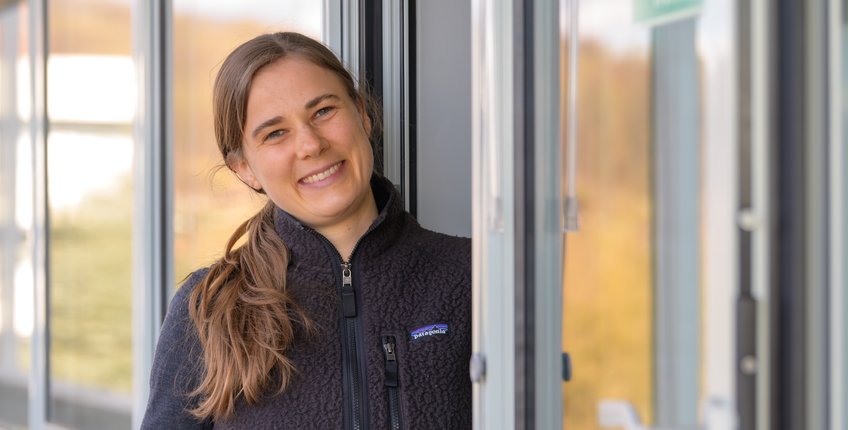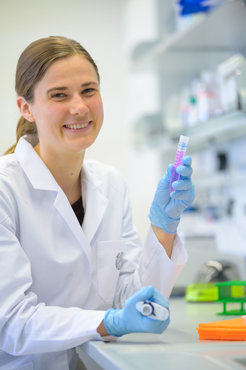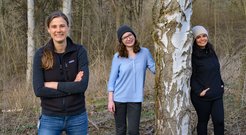
Marieke Oudelaar
Genetic information in three dimensions
Marieke Oudelaar secured a place in the highly competitive Max Planck Society’s (MPS) new excellence program for female junior researchers and now heads the rst Lise Meitner Group at the MPI-BPC. With her team she wants to uncover how the organization of the DNA inside our cells is related to the regulation of the activity of our genes.
Snow crunches underfoot and the spruces on the Faßberg wear fluffy snow-caps. The bone-chilling cold condenses every breath into a white misty haze. Perfect weather for Marieke Oudelaar: “During my time at the Karolinska Institute in Sweden, I enjoyed going on ski tours in the far north. I really loved the cold winters and the snow,” she says. At the institute in Stockholm, Oudelaar completed her master's in biomedicine, before joining the University of Oxford (United Kingdom). There, she stayed for six years, first as a PhD student and later as a Junior Research Fellow. At the beginning of October last year, she took up her new position as Lise Meitner Group Leader at the Max Planck Institute (MPI) for Biophysical Chemistry. As her career progressed, so did the interest in her current area of research.
Talking and silent genes
“I have always been fascinated by the mystery of how a seed becomes a tree or how a fertilized egg becomes a human being,” she recalls. “The curious thing is that such complex organisms contain hundreds of different cell types. These cells perform very different functions, yet all share the exact same genetic information or DNA.” The difference between these cell types is the subset of genes they activate and use. The regulation of this process is the focus of her Lise Meitner Group Genome Organization and Regulation. “We would like to understand at the molecular level how genes are switched on and off,” she states. “In particular, we are interested in how DNA is spatially organized inside the nucleus and how this is related to the regulation of gene activity.”
A cell’s DNA stretched to its full length would be about two meters long. Nevertheless, it needs to t into a tiny cell nucleus that is thinner than a human hair. “This is possible because the DNA is highly compacted and organized in the cell nucleus,” Oudelaar explains. The result is that DNA is folded in speci c three-dimensional structures. These structures influence whether genes can be accessed by activating signals and switched on. However, the details of the mechanisms underlying DNA organization and regulation and their relationship remain obscure. A better understanding of these processes would not only answer important fundamental questions in biology, but is also highly relevant beyond basic research, as aberrant gene regulation plays a role in various diseases. “Genetic variation in regulatory DNA sequences plays an important part in moderating susceptibility to human disease and mutations in such sequences can contribute to the development of tumors.”
Seeking answers in the third dimension

To shed light on how the DNA’s three-dimensional organization is related to gene activity, Oudelaar applies and further develops cutting edge research techniques. “The concept of these methods was developed about two decades ago,” she explains. “We have built on these methods and further pushed the technology to be able to collect more detailed information about the 3D DNA structures formed within the cell.” Another aim is to make the technique more efficient and to limit the required input material: “In the beginning, one had to use millions of cells to get useful data. We are now down to a few thousand. This is an important step, because it allows analysis of human disease-relevant cell types, where sample material is often limited.”
In these so-called chromosome conformation capture (3C) techniques, the DNA inside the cell nucleus is fixed and processed, such that parts of the DNA that are close to each other in 3D space are connected. These newly formed connections are identified using next-generation sequencing. This information can be used to infer the organization of the DNA. “Based on these newly formed connections, we try to puzzle back together the original three-dimensional structure of the DNA in the nucleus,” the biologist sums up. “Here, a lot of computational work is involved.”
Only about half of her work takes place in the so-called wet lab, the other part is carried out in the office using lots of computer power. Oudelaar is therefore recruiting a diverse team, containing experimental and computational biologists. “Ideally, team members should do both the experiments and the analyses themselves. Even when students don’t have a strong background in bioinformatics, I find it important that they get the chance to develop their quantitative research skills. Nowadays, especially in the big data world of genomics, biologists need to be comfortable with bioinformatic analyses.” That is also one reason why she started her group at the institute with only two lab members. “I want to have enough time to supervise everyone properly. We will expand gradually, recruiting a new PhD student in spring and another one in fall.”
Female talents for science
What motivated Oudelaar to accept the position within the MPS’ Lise Meitner Program? “My partner and I wanted to return to continental Europe after six years in the UK. He is German, and I am from the Netherlands,” she explains. “The MPS’ focus on basic research, the generous research funding, and state-of-the-art infrastructure made this offer highly attractive for me. In addition, the Lise Meitner Program provides ideal conditions to start a group,” emphasizes the junior researcher.

Marieke Oudelaar and her PhD students Magdalena Karpinska and Abrar Aljahani (from left).
She first became familiar with the MPI for Biophysical Chemistry through Patrick Cramer and his team, who also work on gene regulation. “It was very clear to me that this is an institute with great colleagues and infrastructure.” In the long term, she would like to use the ample opportunities at the MPI for Biophysical Chemistry to expand and diversify her research. “At the moment, we focus on molecular biology and genomics,” she says. “But I am very keen to integrate more microscopy in our work. This institute offers fantastic facilities and potential to collaborate to explore new microscopy-based tools to study the DNA’s three-dimensional organization.”
Five questions to Marieke Oudelaar
How do you recharge your batteries after a tough day?
I like to go for a run or do yoga – something more physical to relax my brain a little.
What fascinates you most about your job?
I find it really amazing that we have the opportunity to make new discoveries, learn something that no one knew before, and contribute to our knowledge about this world and the living organisms on it.
Which superpower would you like to have?
Ever since I was very little, I thought that it would be amazing to be able to fly.
Which other job could you imagine doing?
I guess I would like to be a writer or a journalist. I could also imagine being a teacher.
What would you do if you had more time?
Work-wise it would be great to have more time to read, both within and outside my eld. If I had to spend more time outside of science, I would try out beekeeping, learn new languages, or play musical instruments. There are so many interesting things to do!
About the Lise Meitner Excellence Program
The MPS established the Lise Meitner Excellence Program to support female talents in science and, in the long term, to bring more female directors to the top of Max Planck institutes. The MPS not only offers material and personnel resources, but also enables female candidates to take up a senior W2 position at an early stage. Every Lise Meitner Group Leader is allowed to participate in a Max Planck-internal tenure track procedure and thus has the chance of a permanent position.
In the first two rounds of applications, around 470 female candidates applied for a position as group leader, of whom 22 received a call. The program was named after the exceptional physicist Lise Meitner, a pioneer in the field of nuclear fission.


